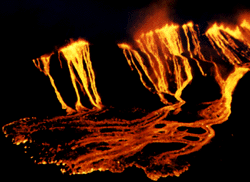

Heart Disease Risk: One Diet Does Not Fit All
Vigorous Exercise for Women May Lead to Greater Health Benefits
Human Genome Lab Groundbreaking
New Device Cleans Water with Light
Research Reveals Growth Factor's Role in Cancer Treatment
New Device Lowers Radiation Exposure During Dental X-Rays

Gas Emissions Provide Clue to Volcanic Activity
New Technique Stops Spread of Hazardous Waste
Virtual Laboratories Debuting on the Internet


Gas Emissions Provide Clue to Volcanic Activity
Mammoth Mountain, a mecca for winter skiers and summer hikers in the eastern
Sierras, recently has attracted the attention of a number of scientists. Part of
an ancient but by no means inactive volcanic basin, the mountain has been sending
out signals of resurgent activity.
Since 1989, when unusual seismic activity began being detected at Mammoth
Mountain, Mack Kennedy of Berkeley Lab's Earth Sciences Division has been part of
a team of scientists attempting to understand what is brewing deep beneath the
surface of this recreational area. The effort is aimed not only at anticipating
events at Mammoth Mountain, but at enhancing our limited ability to discern and
interpret signs of unrest in volcanic areas.
Kennedy's research reveals a hitherto unknown sign of volcanic activity. Trees
that have been dying on the flank of the mountain are not the victims of drought,
as had been thought. Instead, they are being killed by carbon dioxide that is
being emitted as a result of molten rock intruding into the mountain.
The tree kills, which involve four distinct areas totaling some 75 acres, were
first reported in 1990. Over several years, foresters realized that the pattern
did not match that attributable to drought. In the areas where trees were dying,
all trees regardless of age or species were affected, and insect infestations
were not involved.
A year ago, a team that includes Kennedy and researchers at the U.S. Geological
Survey and Lawrence Livermore National Laboratory surveyed soil gases in these
areas. They found carbon dioxide concentrations ranging from about one percent in
healthy forest to as high as 90 percent within tree-kill areas. Where
concentrations were above 30 percent, most trees were dead.
Kennedy's research
indicates that the carbon dioxide soil gas in the tree-kill zones is mostly of
volcanic origin. No other lethal gases were detected. Researchers believe high
concentrations of carbon dioxide kill plants by inhibiting root function.
Mammoth Mountain, which is about 30 miles south of Mono Lake, is part of the Long
Valley caldera that was formed about 760,000 years ago during an eruption 500
times larger than Mount St. Helens. Smaller eruptions have occurred in the area
as recently as 500 years ago.
Researchers report that the total discharge of carbon dioxide from the 75 acres
involved in the vegetation die-off is at least 1,200 tons per day. This is
comparable to that seen during low-level eruptions of a number of volcanoes,
including Kilauea, Augustine, and Mount St. Helens. Scientists say there are no
signs of an imminent eruption at Mammoth Mountain, however the mountain should
continue to be closely monitored.
Typically, the atmosphere includes five parts per million of helium. This
helium consists of two isotopes, helium 3 and helium 4. While helium 4 is
produced constantly in the earth's crust due to the decay of uranium and thorium,
almost no new helium 3 is produced. However, primordial sources of the isotope
remain, almost all buried deep in the mantle. Provided this helium 3 remained
locked in the mantle, the ratio of helium in the air ought to be one hundred
million parts of helium 4 to one part of helium 3. Kennedy reports that at a
Mammoth Mountain fumarole, the ratio of helium 3 recently has ranged from five to
6.7 times that found in air, indicating that magma flowing up from the mantle is
carrying helium 3 with it. Prior to the swarm of seismic activity that began in
1989, that ratio had averaged 3.8.
The ratio of helium 3 in the tree-kill areas is also as high as 6.7 times the air
ratio and the ratio of helium 3 to carbon dioxide is identical to that in the
Mammoth Mountain fumarole, providing evidence that the carbon dioxide responsible
for the tree kills has a magmatic source.
In addition to indicating a resurgence in volcanic activity, Kennedy notes that
monitoring, combined with mapping of high carbon dioxide in soil gas, may provide
an indirect measure of the size, depth, and duration of the molten material deep
inside Mammoth, and help to provide a clearer picture of what lies ahead for the
mountain.
 Although researchers can't directly observe the underground flow of magma, they
can deduce a great deal through the monitoring of the gases it emits. One
effective tracer of fresh magmatic volatiles is a particular helium isotope,
known as helium 3. Kennedy, a member of the Berkeley Center for Isotope
Geochemistry, has led a helium 3 monitoring effort at Mammoth. He reports that
concurrent with the increase in unusual seismic activity, helium 3 levels rose in
1989 and have remained high ever since.
Although researchers can't directly observe the underground flow of magma, they
can deduce a great deal through the monitoring of the gases it emits. One
effective tracer of fresh magmatic volatiles is a particular helium isotope,
known as helium 3. Kennedy, a member of the Berkeley Center for Isotope
Geochemistry, has led a helium 3 monitoring effort at Mammoth. He reports that
concurrent with the increase in unusual seismic activity, helium 3 levels rose in
1989 and have remained high ever since.


